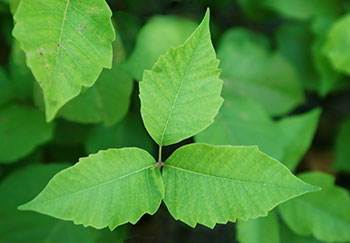
Poison ivy rash is the single most common skin irritation in North America. Poison ivy affects more than 10 million Americans each year.
An oil in the plant, urushiol, causes the nasty skin reaction. The oil is in all parts of poison ivy, including the stem, roots, leaves and skin of the fruit.
Even though poison ivy is so common, there’s still a lot of confusion about avoiding it and treating it. Christopher Holstege, MD, director of the Blue Ridge Poison Center, answers some of these questions.
Myths vs. Facts: How You Get A Poison Ivy Rash
Some people don’t get the rash even after coming into contact with the poison ivy oil.
Fact. Some individuals will not have a reaction to poison ivy. There may be a genetic factor to urushiol sensitivity. One poison ivy study showed 80% of children born to two urushiol-sensitive parents also became sensitive.
You can’t get poison ivy rash from dead plants.
Myth. There are reports that the oil can remain active for 2-5 years (PDF) after the plant is dead and dried. Other sources note that in certain conditions (dry and warm), urushiol could be active indefinitely.
You can get poison ivy at any time of the year.
Fact. The rash typically occurs when you touch the leaves after they’ve been damaged and the oil is exposed. However, all parts of the plant contain the oil, so while it is less likely that you’ll be affected in the cold winter months, it is still possible.
Burning poison ivy in a brush fire is safe.
Myth. Burning poison ivy can result in airborne exposure as smoke particles carry the urushiol oil. When you breathe the smoke, this can cause severe reactions in the lungs.
Subscribe to our blog
Interested in getting more content like this every week? Receive our latest blog posts delivered to your inbox each Friday.
The smoke can also cause skin irritations, which happened to my son when an open burn occurred at a farm near his elementary school, and the smoke blew over the playground. Numerous children developed skin reactions the following day. Thankfully, they were all treated, and none developed respiratory complications. I have also seen this occur with firefighters who work to put out ground fires.
Jumping into a swimming pool can help cure the rash.
Myth. It doesn’t cure the rash, but the cool water does provide some relief. The oil from poison ivy breaks down easily in water.
The best way to treat poison ivy is to gently rinse with cold water and mild soap within 30 minutes if you can. After 30 minutes, most of the oil has already been absorbed through your skin. It is still important to wash at the first opportunity, and all exposed clothing, equipment and pets should also be washed thoroughly with soap and water.
Home remedies like baking soda or oatmeal baths can relieve symptoms.
Fact. Some home remedies like warm baths with baking soda or oatmeal can help relieve the itching that is associated with poison ivy dermatitis. Other ways to treat the rash include cold compresses and calamine lotion. You can also use oral antihistamines and oral steroids.
A Burow’s astringent solution can be applied as a wet-to-dry dressing to help cool and dry weeping blisters.


Burow’s solution = Domeboro Medicated Soak. Great as a compress, or make a paste and slap it on severe cases. That stuff is AWESOME.
You should probably change how this information is formatted. Google search lead me here and the information presented was “Burning poison ivy in a brush fire is safe.” Had I not clicked the link I’d be burning poisoning ivy now.